Tagged: Dodgers
12 Days to Opening Day: Pessimism Reigns
When can a positive become a negative? When you can see how easily it could all fall apart.
Such is the case of the Rangers relief corps as we head to the Spring Training finish line. For all the questions about the starting rotation, the relief corps has been seen as potentially one of the strongest in the American League. So strong that many could see no shortage of depth even if 2010 closer Neftali Feliz joined the starting rotation in 2011.
Please, Rangers coaching staff, don’t let that happen. I’m beginning to think Feliz as closer is essential to the Rangers successfully defending the AL West.
Look at the two people most prominently mentioned as candidates to replace Feliz as closer. Mark Lowe has gotten torched in Spring Training: 7 Innings, 14 Hits, 11 Earned Runs. Alexi Ogando, who’s been stretched out as a starter candidate, was doing OK until his last appearance when he couldn’t make it out of the 8th against the Dodgers.
Also consider the Rangers two LOOGY’s: Arthur Rhodes and Darren Oliver, are 41 and 40 years of age respectively. And lastly, there’s the 7th inning guy, Darren O’Day.
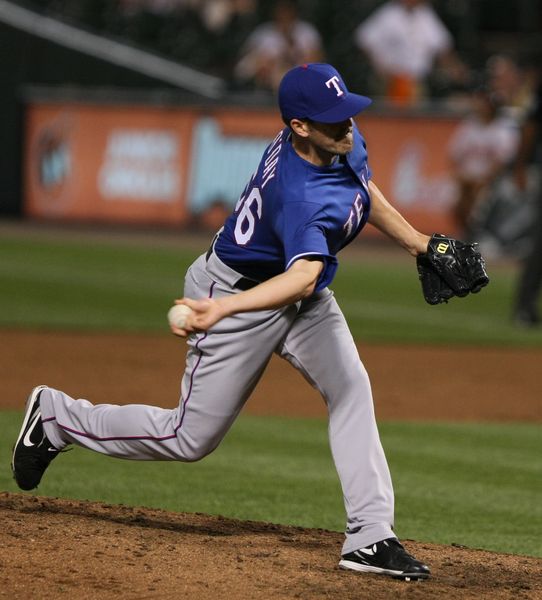 O’Day is the one I am most concerned with at this point. The righthanded sidearmer has had a wonderful two year run with the Rangers, a 1.99 ERA over 136 games, a 0.918 WHIP and a 3.41 strikeout to walk ratio. Rangers fans have taken to singing his name when he comes into games, changing the familiar soccer tune “Ole Ole” to “O’Day O’Day”. As of September 3rd, O’Day’s 2010 featured a sparkling 1.51 ERA, only 36 hits given up in almost 54 innings and only one home run given up the whole season.
O’Day is the one I am most concerned with at this point. The righthanded sidearmer has had a wonderful two year run with the Rangers, a 1.99 ERA over 136 games, a 0.918 WHIP and a 3.41 strikeout to walk ratio. Rangers fans have taken to singing his name when he comes into games, changing the familiar soccer tune “Ole Ole” to “O’Day O’Day”. As of September 3rd, O’Day’s 2010 featured a sparkling 1.51 ERA, only 36 hits given up in almost 54 innings and only one home run given up the whole season.
Since September 3rd, though, life has not been good for Darren O’Day. He closed out the regular season giving up four home runs in his last nine games over just 8 1/3 innings. In the post-season, O’Day pitched 11 more games, but only lasting 4 2/3 innings in that time, giving up two more bombs and compiling a 7.71 ERA.
Now, in Spring Training, O’Day has pitched in six games. In 7 innings of work, he’s given up 16 hits, 8 runs and 5 home runs. Since September 3rd of last year, all told he has given up 11 home runs over his last 20 innings. Making matters worse, O’Day says he and pitching coach Mike Maddux have been going over video and can’t find any flaws in his delivery.
This is beginning to remind me of a pitcher the Angels had in their glory days of ’02 and ’03. Ben Weber had a different type of delivery (nothing like O’Day’s) and had ERA’s of 2.54 on 2002 and 2.69 in 2003 has one of the Angels’ set-up guys. His post-season ERA in 2002, though, was a robust 10.80. In 2004, the wheels came off. Weber went 0-2 with a 8.06 ERA in 18 games with the Angels, followed by 10 games with an 8.03 ERA for the Reds in 2005 and his major league career was over.
Some pitchers, once batters figure them out, never recover. Will this be Darren O’Day’s fate? I sure hope not. But that thought, combined with the other potential threats mentioned earlier among the relief corps, has me hoping the Rangers keep Feliz in the bullpen.
In other news: A week ago, the competition couldn’t have been stronger for the 3rd, 4th and 5th slots in the starting rotation. Then nobody pitched as though they wanted it badly enough. Derek Holland, Michael Kirkman, Tommy Hunter, Eric Hurley and Matt Harrison all had middling to poor outings over the past week. Holland recovered to pitch five solid innings against the Royals on Sunday.
In a radio interview, Mike Maddux indicated the Rangers are pretty close to deciding on Harrison and Hunter for two of the three available starting slots, leaving one slot open for Kirkman, Holland or Feliz (Hurley was optioned to AAA Round Rock the other day). If Feliz goes to the bullpen (and he pitched 5 solid innings Saturday), I see Holland as the last rotation slot. If Feliz stays a starter, he’ll probably get the last spot with Holland either going to long relief or back to Round Rock for now.
Too many starters is a good problem to have. If one falters, the hope is Brandon Webb will be ready by then to take his place. Most teams have one or two starters go on the DL every season as well. While all Rangers fans would love to see a true ace in the rotation, having as many as four starters on your AAA staff that already have the talent to compete on the major league level helps pave the way to inner peace!
Last item of pessimism: Julio Borbon has forgotten how to play defense. A year ago, first base coach Gary Pettis, a former center fielder himself, took Borbon under his wing and taught him the art of playing center field. His defense in 2010 was infinitely superior to what he showed in 2009.
This spring, however, Borbon has looked terrible in the field, having committed five errors- some throwing, some fielding. Even an average center fielder won’t commit five errors in an entire season, let alone 15 exhibition games. Borbon blamed the bright sun of Arizona for some of the miscues (I could buy that in the one TV game in which he had an error), but then he had two errors in a night game against the Padres. Borbon is hitting well and running the bases well this spring, but his defense is making a lot of people uneasy. The Rangers have even toyed with playing David Murphy some in center. They really do not want Josh Hamilton playing out there fulltime in 2011.
For a lot of players, the next seven days represent crunch time. Can Chris Davis hit his way onto a team with no real open position for him? Can O’Day and Lowe turn it around? Will Feliz start or finish? Will Michael Young or Davis get traded? Will there be some surprise releases or demotions? Stay tuned for our next episode, same bat time, same ball channel!
“The Face” Becomes “The Story”
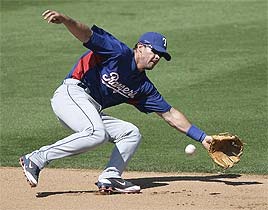
“The Face” of the Texas Rangers
It’s amazing what a World Series appearance does for a team on the national stage. Just in the past week alone, two of the top stories in baseball have been “The War of Words” between Rangers owner Chuck Greenberg and the Yankees and “The Michael Young Trade”. I don’t remember the Rangers ever getting this much oress from the national media in January. Heck, I don’t even remember the Rangers getting this much press in January from the LOCAL media!
I really don’t know if the Rangers are getting ready to trade Michael Young or not. What I DO know is that NONE of the speculation being reported by national writers and broadcasters has come from the Rangers side!
The story first cropped up during the Winter Meetings and was quickly quashed as just names being brought up as they always are when possible trades are discussed. Hey, if you don’t ask about someone you’ll never know, right?
It came up again the day the Rangers signed Adrian Beltre to a 6-year contract and announced that Young would, in 2011, become the Rangers primary DH and play a “Super Utility” role on the Rangers infield. Young said it wasn’t an ideal situation for him, but he was a Ranger through and through and was willing to make the move, with the hope of becoming a fulltime field player again in the future.
“The Story” took on a life of its own, however, the day the Rangers traded Frank Francisco to the Blue Jays for Mike Napoli. As I stated in a post at the time, I didn’t see it as a threat to Young. I saw it as a great way to give the Rangers incredible versatility in their line-up on a day to day basis, as a platoon first baseman, a DH when Young plays the field and a catcher if one of the other two catchers went down with an injury.
Harold Reynolds of MLB TV was the first of the national media I heard chime in that day, saying Young should now DEMAND a trade because there was no reason to obtain Napoli except to take at bats away from Young. Since then, we have heard a deal with the Rockies is imminent, but then again maybe it isn’t. That maybe the Rockies aren’t the only ones in the mix for Young, that he could go to the A’s… or the Angels… or the Blue Jays… or the Dodgers!
The only way trading Michael Young makes sense is if 1) he demanded a trade; 2) if they don’t deal him by May, Young becomes a 10-5 player who can veto ANY trade if he so desires; and 3) if they either get a frontline starting pitcher in return or a DH who can equal his 20+ HR’s and 90 RBI in the offense.
The reasons a Young trade DON’T make sense are 1) Young is the Rangers bona fide leader on the field, an intangible that could have a disastrous effect on the clubhouse; 2) every piece of media speculation indicates the Rangers would have to add dollars to the deal to help the other team offset Young’s $16 million salary over the next 3 years, which means any deal would make little financial sense; and 3) if they don’t get a frontline pitcher or replacement DH, as most reports indicate they won’t, the Rangers won’t be improving the team, which GM Jon Daniels says is the goal of every deal the Rangers make.
Replacing Young with Napoli straight up at the DH slot doesn’t add up. Young routinely is in the line-up for 600+ AB’s every year, while Napoli’s only had a high of 453, which was last year. He also hit only .238 last year. Platooning Napoli with David Murphy at DH? Maybe, but then the Rangers lose the versatility the line-up has right now with Young still on the team.
Maybe Young is unhappy. Maybe he does want a trade. The thing is, in all the reports making the news these days, who are we not hearing from at all? Young and the Rangers, that’s who.
The Rangers have become famously tight-lipped over the past two years. Cliff Lee? Everyone assumed he was going to be a Yankee at mid-season last year until the Rangers came in and got him. Adrian Beltre? Assumed to be an Angel, until the day before the Rangers announced his signing. January’s trade for Napoli? Not on ANYONE’s radar in the national media.
As for Young? Maybe he learned a lesson when he publicly demanded a trade when he was first asked to move to third base to make way for Elvis Andrus and is keeping his feelings private. But maybe not. Have any of these reports indicated the writer has even bothered to ask Young what he thinks about it or what he knows? Not a one. If they had, they would at least say something along the lines of, “Young declined to comment on the matter.”
Here’s what HAS been said. Michael Young has stated he wants to remain a Ranger for the rest of his career. Ron Washington says Michael Young is the straw that stirs the Rangers coffee. Jon Daniels says the Rangers have no plans to deal Young this year. Nolan Ryan says Michael Young is going to be the Rangers DH at the Season Opener against the Red Sox on April 1st.
Until I see something actually happen, I think I’ll trust the words from that last paragraph before I trust any of the others I’ve read and heard lately.
The Shlabotnik Non-Stars: Bobby Witt, RHP
In honor of Joe Shlabotnik, Charlie Brown’s favorite player in the Peanuts comic strip, here is the latest player in Rangers history who we rooted for even when things didn’t work out.
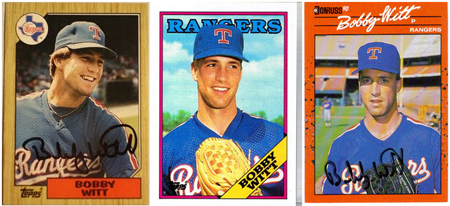 Here’s the Shlabotnik Non-Star mentioned most often in my blog posts, almost always as a point of comparison to the latest Rich Harden outing.
Here’s the Shlabotnik Non-Star mentioned most often in my blog posts, almost always as a point of comparison to the latest Rich Harden outing.
Bobby Witt grew up in the backyard of the Washington Senators in Arlington, Virginia. Maybe it was that connection that kept Bobby from signing with the Cincinnati Reds when they drafted him out of high school in 1982. Regardless, he decided to go to the University of Oklahoma instead, where the Rangers made him their first round draft choice (and #3 pick overall) in 1985.
Bobby’s first year in the minors was with AA Tulsa in 1985, where he went 0-6 with a 6.43 ERA. This was the beginning of the Bobby Valentine era in Arlington. In 1986, Valentine decided it was time to start over from scratch and it really showed in the pitching staff. Despite a minor league career that comprised only 11 games and no wins, Bobby Witt made it to the Rangers in 1986, joining a starting staff that comprised one veteran (Charlie Hough) with four rookies (Witt, Kevin Brown, Edwin Correa and Jose Guzman).
The first four years of his career saw Witt lead the American League three times- in walks. He also led the league twice- in wild pitches. And he led the league once- in earned runs allowed. Needless to say watching Bobby Witt was an adventure, and that’s without even considering the games Witt started that Mitch Williams then came in to pitch. Yeesh!
Despite these adventures in pitching, Witt actually managed a winning record in 1986, going 11-9 with a 5.48 ERA during the Rangers surprise run to an 87-75 finish. Mostly, though, Witt was the consummate .500 pitcher, plus or minus a win throughout most of his Rangers career. He followed up his 11-9 with 8-10 records in ’87 and ’88 and 12-13 in 1989.
“Promise” is the word most used about Witt in these early years. You got the feeling that one day Witt, as with all the young Rangers, would figure it out, put it all together and propel the Rangers to greatness. In 1990, Rangers fans thought that had finally happened with Bobby Witt.
The season started out in typical Witt fashion. A good game here, a couple of bad games there, control issues just about every game. By the time June was almost at a close, Bobby sat at 3-8 on the year with a 4.97 ERA. On June 28th, Witt faced the Twins in the Kingdome, allowing one run in seven innings in picking up the win. He followed it up with a complete game win over the Orioles. After a no decision against the Red Sox, Witt then ripped off seven wins in seven starts with three complete games and four double digit strikeout games. From June 28th through the end of the season, Witt went 14-2 with a 2.40 ERA and a 12-game winning streak. Singlehandedly, Bobby Witt kept the Rangers in the AL West race, though they would end the season just four games over .500 at 83-79.
Bobby Witt ended the 1990 season with a 17-10 record and a career low 3.36 ERA. The sky was now the limit for the righthander with “promise”.
1990 turned out to be a tease. It was by far Witt’s best season in the majors and he never came close to the dominance he showed that year. In 1991, Witt went 3-7 with a 6.09 ERA. In 1992 he was 9-13 with a 4.46 ERA. The Rangers were out of the pennant race at 65-69, Bobby Valentine had been fired, Ruben Sierra was unhappy and had regressed. The division rival A’s were in the pennant race, however, so Texas made a bold move. The Rangers sent Witt packing to the Oakland A’s, along with Jeff Russell and Ruben Sierra, in exchange for Jose Canseco.
Witt spent the rest of the ’92 season, along with 1993 and 1994, with Oakland where he pitched like, well, Bobby Witt, going a combined 23-24 with an ERA in the upper 4’s. Witt signed as a free agent with the Florida Marlins. In 19 starts, Witt was 2-7 with a reasonable (for him) 3.90 ERA when the Marlins traded him back to Texas for Wilson Heredia and Scott Podsednik (bet many of you didn’t know he was originally in the Rangers organization). Down the stretch Witt was 3-4.
1996 was the year of the Rangers’ first division title and trip to the playoffs. You could say Bobby Witt was a major factor in that success. He did go 16-12 on the year but that’s as much a testament to the Rangers offense, which now featured the killer trio of Palmeiro, Rodriguez and Gonzalez. Witt’s ERA was a robust 5.41 for the division winners. Witt’s only playoff appearance for the Rangers was in ’96 when he gave up three runs in 3 1/3 innings against the Yankees.
Bobby followed up the ’96 campaign with a 12-12/ 4.82 ERA mark in 1997. After resigning with the Rangers for 1998, he was 5-4 with a nasty 7.66 ERA when the Rangers sent him to the St. Louis Cardinals. He would never pitch for the Rangers again. Witt finished his career going 7-15 for Tampa Bay in 1999, 0-1 for Cleveland in 2000 and 4-1 for Arizona in 2001. Astonishingly enough, Witt got a World Series championship ring in his final year in the majors, throwing one shutout inning for the Diamondbacks against the Yankees.
Bobby Witt ended his career with a 142-157 record and a career ERA of 4.83. For his Rangers career, Witt was 104-104, 4.85.
Other career highlights: With Oakland, Witt had a one-hitter that would have been a no-hitter were it not for a blown call in the 6th inning. He is also the first American League pitcher to have hit a home run since 1972 when he hit one in interleague play against the LA Dodgers in 1997 while a member of the Rangers.
The Shlabotnik Non-Stars: Scott Fletcher, SS
Honoring the Rangers/Senators version of Joe Shlabotnik, the guy nobody but Charlie Brown would root for in the comic strip Peanuts.
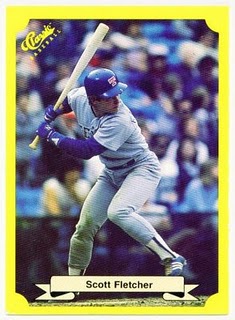
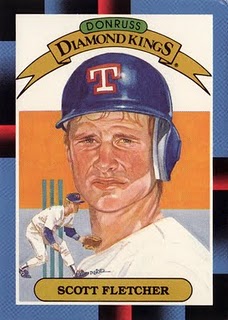
Of all the Shlabotnik Non-Stars, this one is probably my favorite. In fact, he might be the only team member who would have been a valuable addition to the Rangers AL West pennant winners (no disrespect to Kevin Elster). His departure will forever be enshrined in a Rangers Hall of Shame. More on that later.
Scott Fletcher manned the shortstop hole in the Rangers line-up during the Bobby Valentine years, which saw a whole new generation of Rangers break into the league for the first time: Kevin Brown, Pete Incaviglia, Jose Guzman, Bobby Witt and Mitch Williams among them.
Fletcher was not a home-grown Rangers product. The Wadsworth, Ohio native, who played college ball for both the University of Toledo and Georgia Southern, had been on MLB’s radar for some time. The Dodgers tried to draft him in 1976, the A’s in the first round in January ’78 and the Astros in the 1st round in June of ’78 all tried to sign him. The Cubs finally succeeded when they made Fletcher the 6th pick in the June Secondary draft in 1979.
After two cups of coffee in the NL in ’81 and ’82, the Cubs dealt Fletcher to the White Sox, where he became a semi-regular in 1983. Two years later, the Chisox dealt him to the Rangers in what turned out to be a steal: Fletcher, Ed Correa and Jose Mota for Dave Schmidt and Wayne Tolleson.
Fletch quickly became a fan favorite. In 1986, he played in 147 games, splitting time between second, short and third, but mostly playing shortstop. The Rangers surprised everyone by contending in the AL West, finishing 87-75 for a strong second place finish just five games behind the Angels. Fletcher was a big part of the success, compiling a .300 batting average with 82 runs scored, 34 doubles, 3 home runs and 50 RBI. At one point, Fletcher compiled a 19-game hitting streak in July of ’86, as well as a 23-game streak of reaching base at least once per game. Defensively Scott was no slouch either, ending with a .973 fielding percentage at short.
By 1987, Fletcher was the fulltime Rangers shortstop, appearing in all but six of the Rangers games. While the team backslid to 75-87, good for 6th place in the West, ten games behind the Twins, Fletcher was a mainstay and steadying influence on the young team. While his batting average dipped a bit to .287, Fletcher still scored 82 runs, upped his RBI output to 63 and drew 61 walks as well. Defensively, Fletch was third in the league in putouts by a shortstop and fourth in the league in shortstop assists.
Fletcher’s last full year with the Rangers was 1988. The Rangers backslid once again to a 6th place 70-91 record, a ******** 33 ½ games behind the division winning Oakland A’s. In 140 games, Fletcher’s average again dipped, this time down to .276. His runs, RBI’s, extra base hits and walks all turned downwards as well, though he hit a career high with fifteen sacrifice bunts, fourth best in the AL and was 3rd in the AL by getting hit with a pitch 12 times. Defensively, Fletcher excelled in ’88, committing just 11 errors at short for a .983 fielding percentage, second best in the AL.
In 1989, the Rangers fortunes turned around once again. By mid-season, the team was in the hunt for the AL West crown and GM Tom Grieve knew a bold move could be the turning point to getting his team into the playoffs. Rolling the dice on a hitter with a proven track record, Grieve made one of the most infamous trades in Rangers history, sending Scott Fletcher back to the White Sox in a deal that netted the Rangers Harold Baines and infielder Fred Manrique. The trade wasn’t infamous because it sent Fletcher away from the team, although there were many fans that were sad to see him go. No, what made the deal infamous were the two other players the Rangers threw in- pitcher Wilson Alvarez and a rookie outfielder by the name of Sammy Sosa. In all fairness, Fletcher probably produced the best of those players for the White Sox after the fact, but Baines never produced for the Rangers as he did for the White Sox and we all know what kind of career Sosa ended up having.
Scott Fletcher would remain in the bigs ’til 1995. After the Rangers, he had stints with the White Sox, Brewers, Red Sox and Tigers. He ended up having a 15 year career, hitting .262 and piling up over 1300 hits. And though the Rangers have had some good, even great, shortstops through the years, I think Fletcher remained my favorite until Elvis Andrus came along.